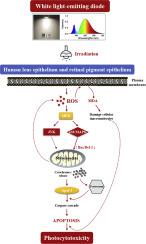Journal of Photochemistry and Photobiology B: Biology ( IF 5.4 ) Pub Date : 2020-10-21 , DOI: 10.1016/j.jphotobiol.2020.112058 Jiayin Song , Daoyong Li , Zhongshu Shan , Olga Kurskaya , Kirill Sharshov , Tingting Gao , Hongtao Bi

|
WLEDs have lately been the preferred lighting device based on properties such as energy saving, high efficiency, longevity, and environmental protection. However, studies on the safety of white light-emitting diode (WLED) are limited. In our previous study, we found that WLED light (4000 K ± 500 K color temperature, 250 lx, and 20 min exposure) is photocytotoxic to three mammalian cell lines by causing cell lipid peroxidation. To further investigate the potential photocytotoxicity of WLEDs on the human body, we used two human eye cell lines SRA01/04 and D407 as target cells for evaluating its potential phototoxicity on the human eye in the present study based on cell viability, apoptosis, and intracellular oxidative stress assays, as well as the activation levels of reactive oxygen species (ROS)-related apoptosis pathways, including extracellular signal-regulated kinase (ERK), c-Jun NH2-terminal kinase (JNK) and p38 kinase (p38), using mitogen-activated protein kinase (MAPK) signaling pathway assays. The results showed that WLED light has photocytotoxicities on SRA01/04 and D407 cells, which were both in a time-, irradiance-, and color temperature-dependent manner and strongest at the conditions of 2 h irradiation time, 60 W/m2 irradiance, and 4000 K color temperature. Moreover, the photocytotoxicity of red light-emitting diode (LED) light was the strongest in the three tested monochromatic light compositions of WLED. Mechanism studies show that the potential phototoxicity of WLED on human lens epithelium and retinal pigment epithelium may be caused by its induced oxidative stress damage via the JNK and p38 MAPKs pathways.
中文翻译:

通过JNK和p38 MAPK信号通路,白光发射二极管对人晶状体上皮和视网膜色素上皮的光毒性
基于节能,高效,寿命长和环境保护等特性,近来WLED成为首选的照明设备。但是,关于白光发光二极管(WLED)的安全性的研究受到限制。在我们之前的研究中,我们发现WLED光(4000 K±500 K色温,250 lx和20分钟曝光)通过引起细胞脂质过氧化作用,对三种哺乳动物细胞系具有光细胞毒性。为了进一步研究WLED对人体的潜在光毒性,在本研究中,我们基于细胞活力,凋亡和细胞内,使用两种人眼细胞系SRA01 / 04和D407作为靶细胞,以评估其对人眼的潜在光毒性。氧化应激试验以及与活性氧(ROS)相关的凋亡通路的激活水平,包括细胞外信号调节激酶(ERK),c-Jun NH2末端激酶(JNK)和p38激酶(p38),使用促分裂原活化蛋白激酶(MAPK)信号通路分析。结果表明,WLED光对SRA01 / 04和D407细胞具有光细胞毒性,二者均呈时间,辐照度和色温依赖性,并且在2 h辐照时间60 W / m的条件下最强2辐照度和4000 K色温。此外,在三种测试的WLED单色光成分中,红色发光二极管(LED)的光细胞毒性最强。机制研究表明,WLED对人晶状体上皮和视网膜色素上皮的潜在光毒性可能是由其通过JNK和p38 MAPK途径引起的氧化应激损伤引起的。



























 京公网安备 11010802027423号
京公网安备 11010802027423号